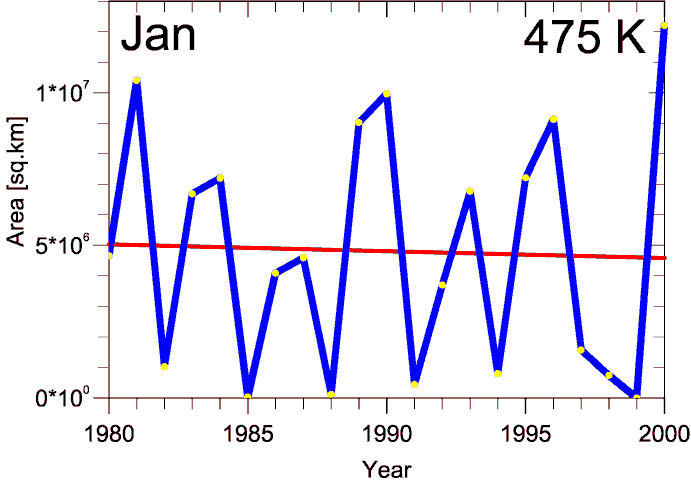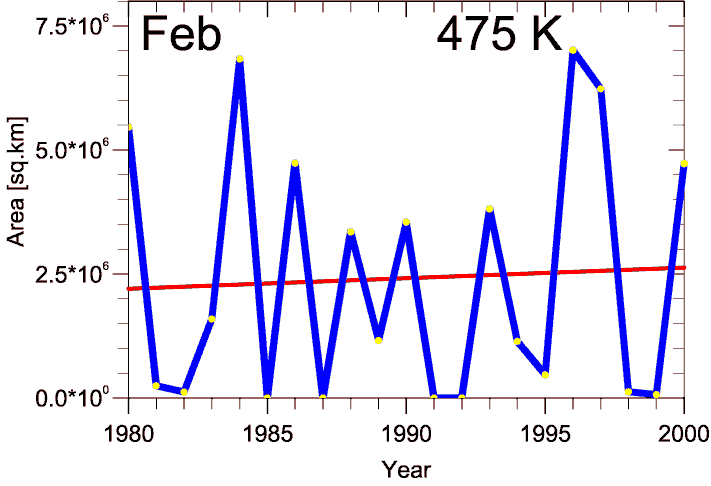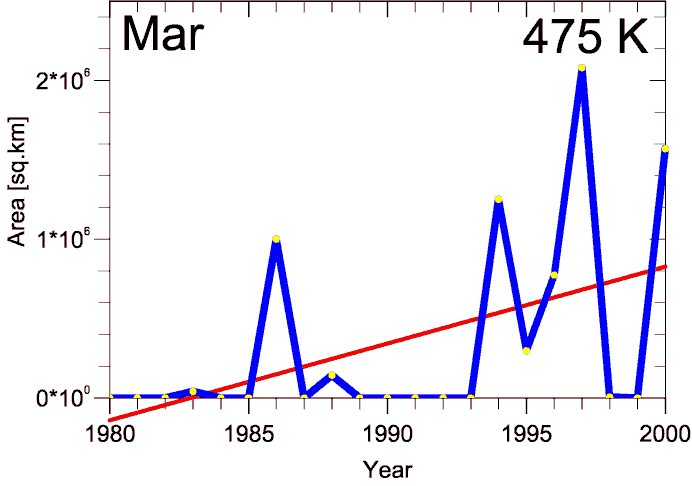Polar vortex climatology from the ECMWF ERA-15 data set
Geir O. Braathen1, Michael H. Proffitt2 and Frode Stordal1
1Norwegian Institute for Air Research, N-2027 Kjeller,
2World Meteorological Organization, Geneva
FIGURES
- Figure 1
- Figures 2 Jan., Feb., Mar., Apr.
- Figures 3 Jan., Feb., Mar., Apr.
- Figures 4 Jan., Feb., Mar., Apr.
- Figures 5 5a, 5b, 5c, 5d
- Figures 6 Jan., Feb., Mar., Apr.
- Figures 7 7a, 7b, 7c, 7d
- Figures 8 Jan., Feb., Mar
- Figures 9 9a, 9b, 9c, 9d
- Figures 10 Sep., Nov., Dec.
- Figures 11 Sep., Nov., Dec.
- Figures 12 Sep., Nov., Dec.
- Figures 13 Sep., Nov., Dec.
Abstract
Introduction
As part of the EU project Polar Vortex Change (PVC, coordinated by Esko Kyrö, FMI) NILU has acquired the 15-year ECMWF re-analysis set, the so-called ERA-15 data set. ERA-15 covers the period from 1 Jan. 1979 to 28 Feb. 1994. The data are global in coverage and in spectral form at T106 resolution. Converted to a latitude/longitude grid the resolution is 1.125° X 1.125°. The 32 levels reach from the ground to 10 hPa. In addition we have acquired daily global fields at T106 resolution from 1994 up to present. The combined data set makes it possible to study the climatology of the polar vortex in a 20-year perspective. In the present study we have looked at the development of various polar vortex parameters from 1979-80 until present. We have limited the study of the Arctic vortex to the four months January through April and to the isentropic level of 475 K (approx. 19 km or 50 hPa). The Antarctic vortex has been studied at several levels from 400 to 550 K and for the months September through December.
The Arctic Vortex
Minimum temperatures
The minimum temperature anywhere north of 40°N has been used by several investigators as a parameter to characterise the temporal development of the polar vortex through the winter. Figure 1 shows how this parameter has evolved during individual winters for the last twelve years. It is seen from the figure that the winter 1999-2000 (thick curve in magenta) for certain periods is colder than any of the previous winters shown here. One can also see that the winter before (1998-99) had some of the warmest minimum temperatures during this 12 year time span.
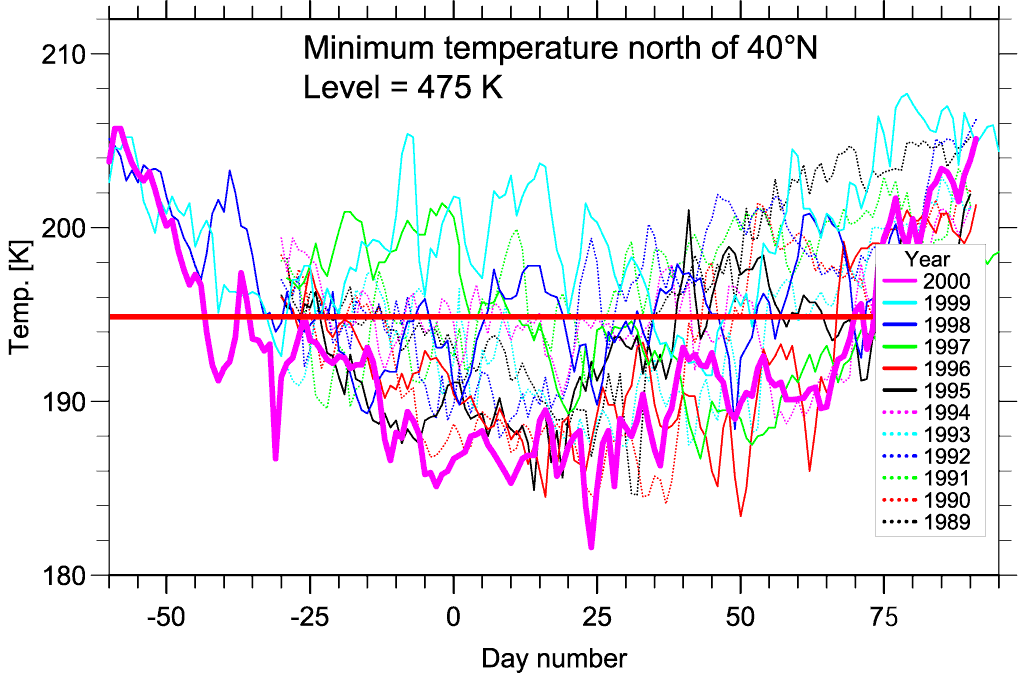
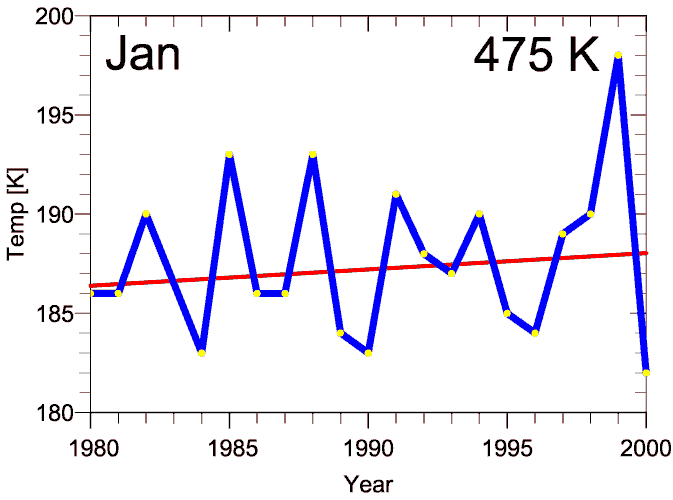 |
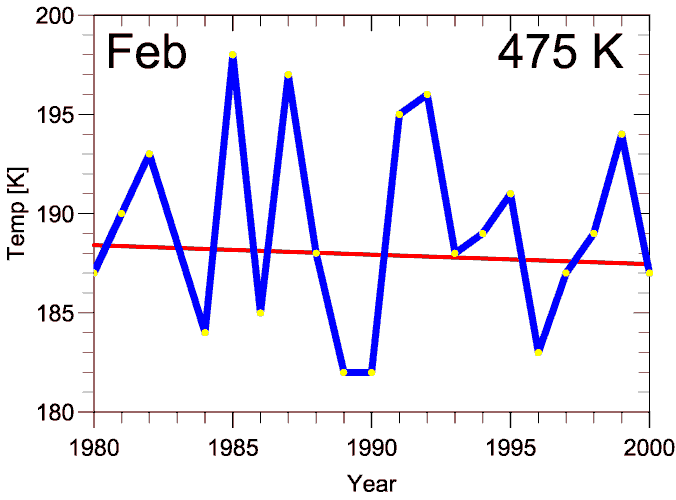 |
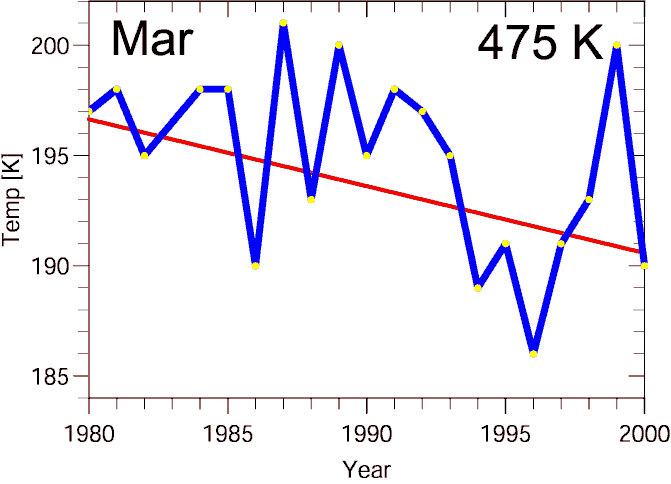 |
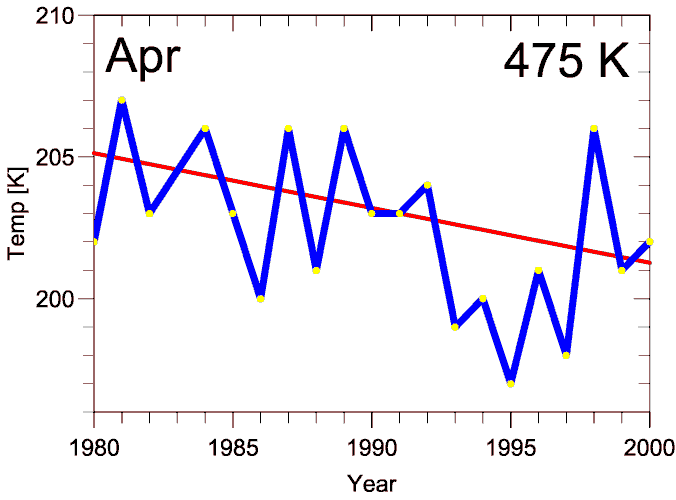 |
Vortex area
The area of the polar vortex can be used as a quantity to describe the evolution of the vortex. We have calculated the monthly mean vortex area defined as the area where PV > 42·10-6 Km2/kgs at 475 K. The trend in these monthly means is shown in Figure 3. For January it can be seen that the highest monthly mean vortex area was reached in 2000 with an area of 2.09·107 km2 (1989 was close with 2.06·107) It can also be seen that 1999 had the smallest January vortex during this 21-year period. The plot for February shows that 1996 has the largest vortex and that 1987 had the smallest. In March, and esp. in April, it becomes apparent that the 1997 vortex was quite unique in terms of stability late into the spring. These plots show that there is a clear tendency towards longer-lived Arctic vortices and the trend for both March and April are significant well above the 2s level (see Table 1).
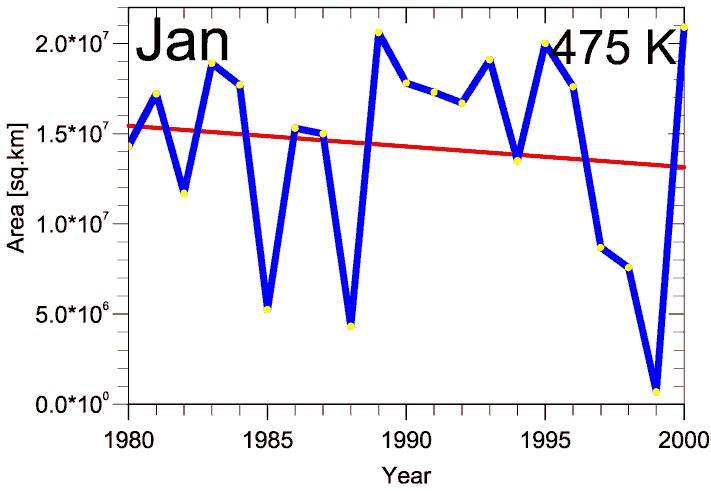 |
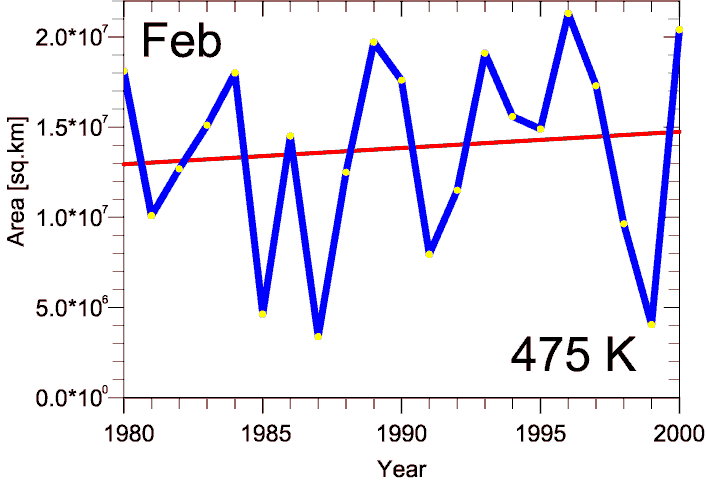 |
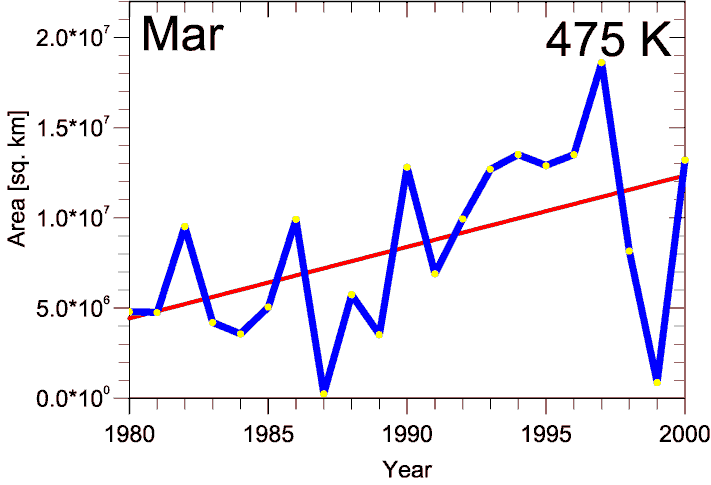 |
 |
Mean potential vorticity
The mean PV value inside the vortex (defined as PV > 36 PVU in this case) can be used as a parameter to study the stability or strength of the vortex. We have calculated vortex monthly mean PV values for the 21 years studied here. The trend in this parameter is shown in Figure 4. For January there is no significant trend, but for February the trend is significant within the 1s limit. The very weak vortex of 1999 can be seen from all four panels. Both March and April show positive trends that are well above the 2s level (see Table 1)
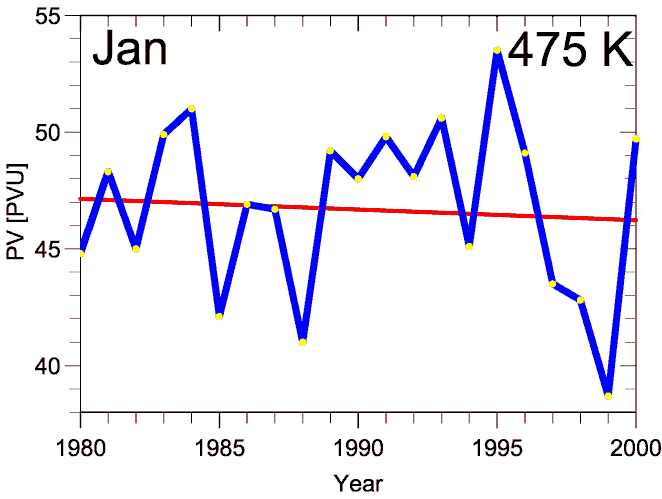 |
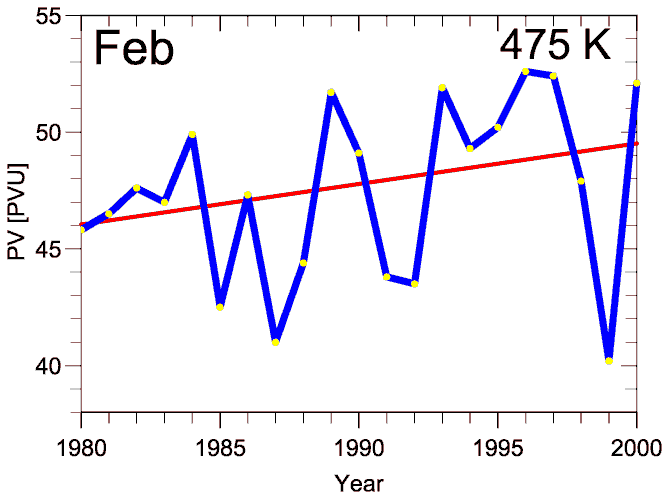 |
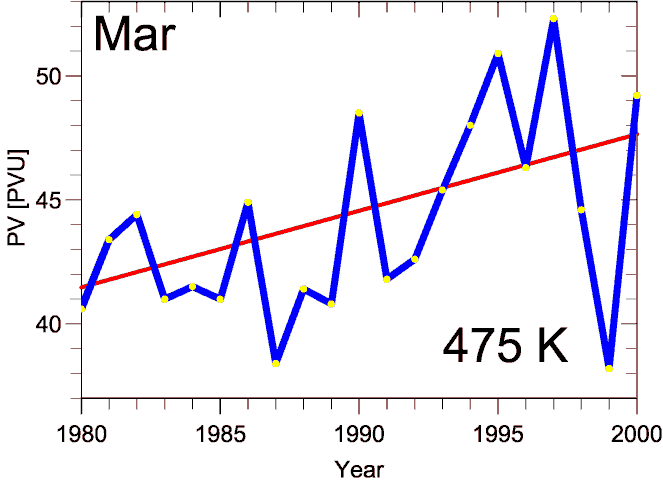 |
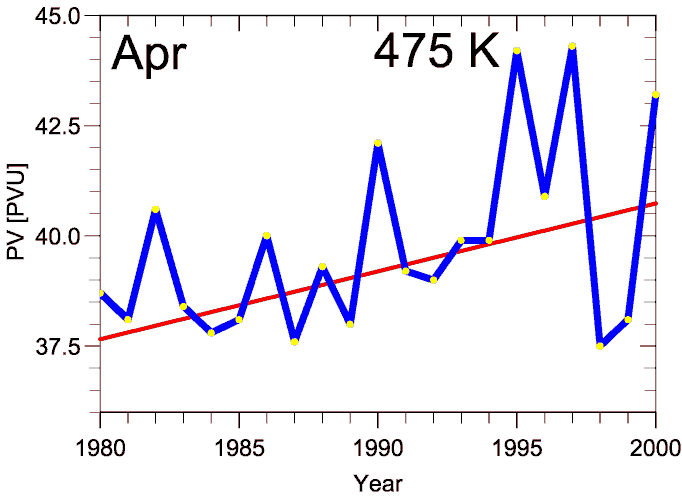 |
Vortex strength
Figure 5 shows a parameter that combines the vortex area and the PV strength. One also gets an impression of the longevity of the polar vortex for the last 21 winters. One can see a tendency towards more long-lived vortices during the last years. This extends the possible period for ozone depletion, either through halogen chemistry if the temperature is low enough, or through NOx chemistry if the vortex lasts well into spring (such as in 1997)
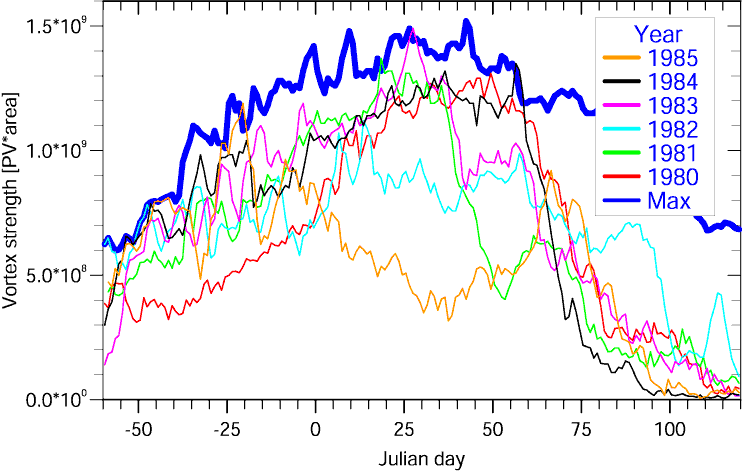 |
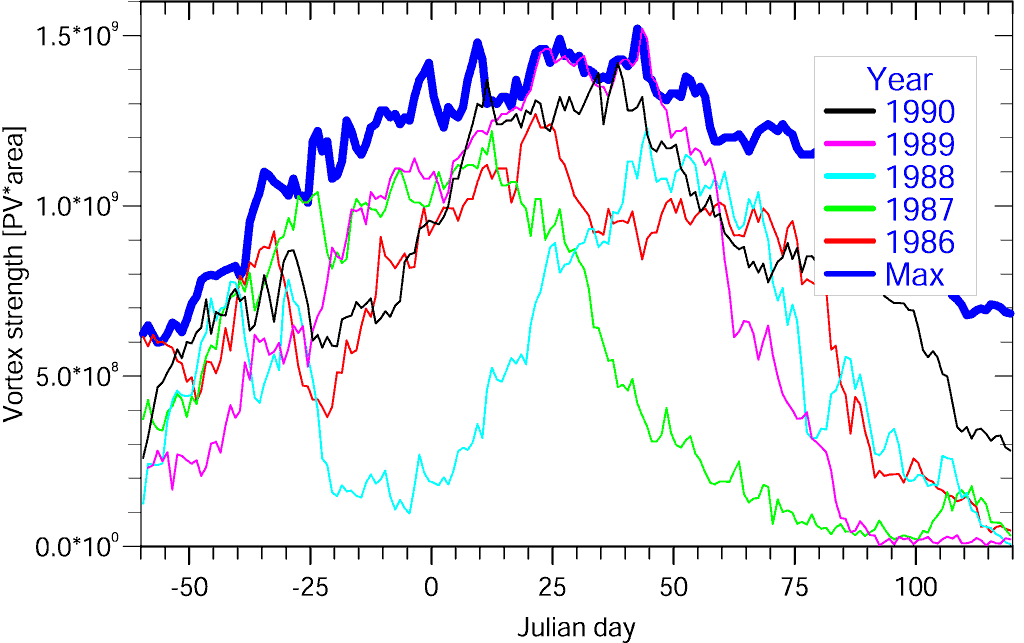 |
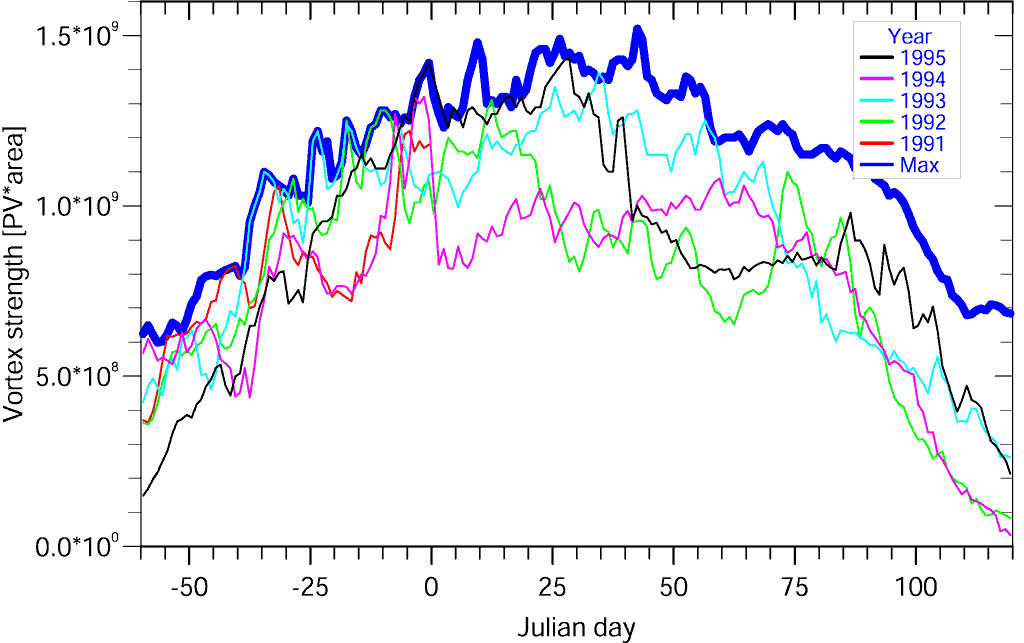 |
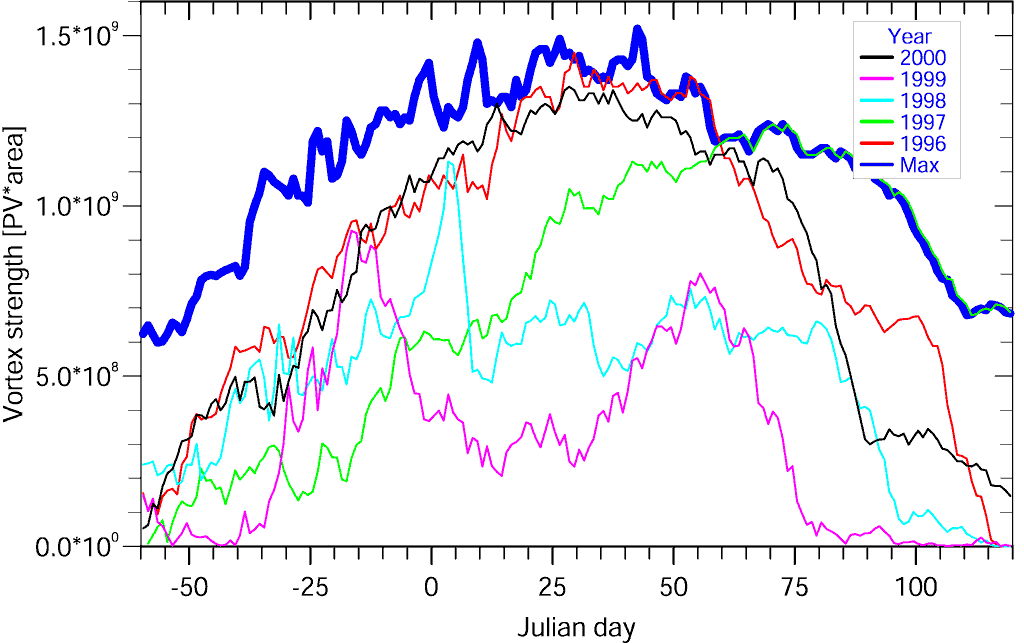 |
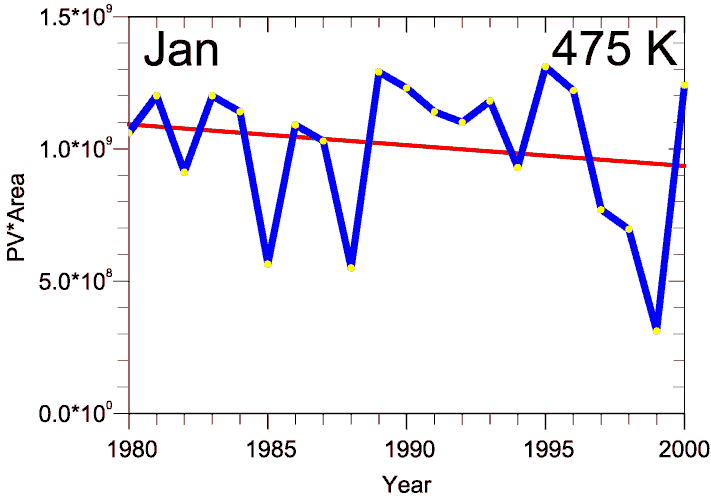 |
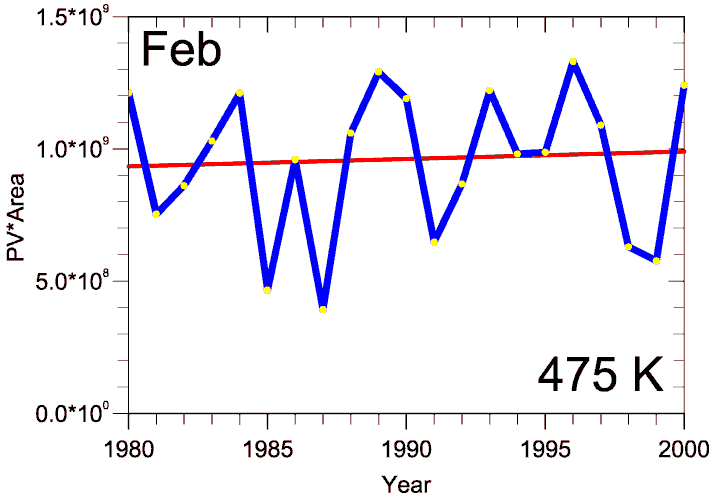 |
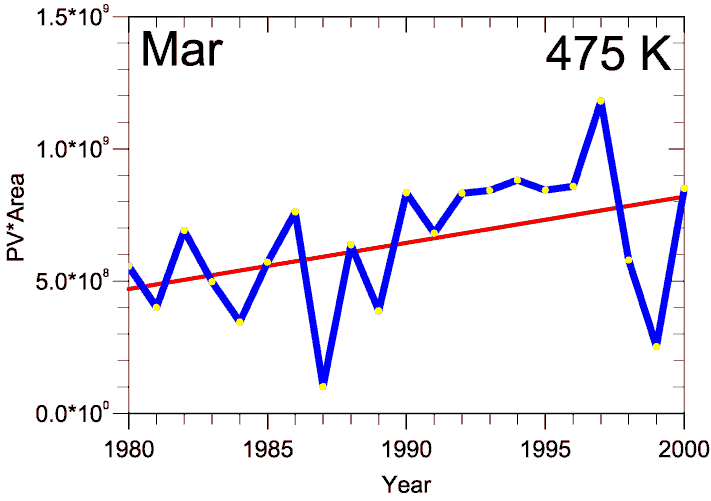 |
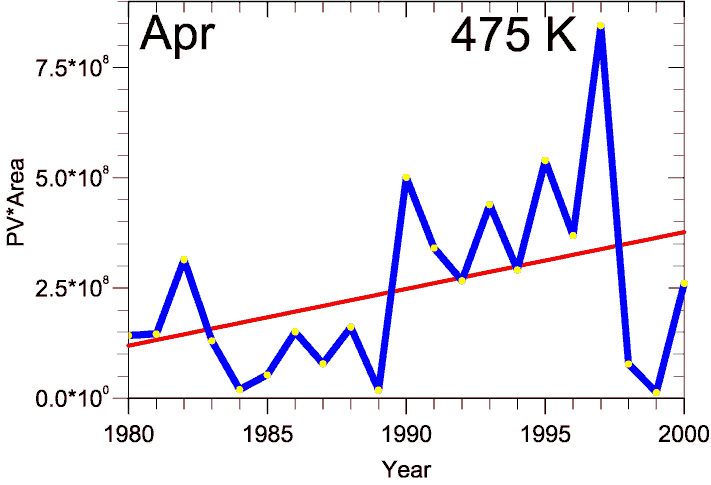 |
PSC area
The geographical area with temperatures low enough for PSC type I condensation is often used as a proxy for the degree of activation. Figure 7 shows the temporal behaviour of this parameter as a function of date throughout the 21 winters from 1979-80 to 1999-00. From these plots one can see a tendency towards more winters with NAT temperatures through most of the winter from December to March. The winters of 1995-96 and 1999-2000 stand out as particularly cold with NAT temperatures from early winter into the late winter
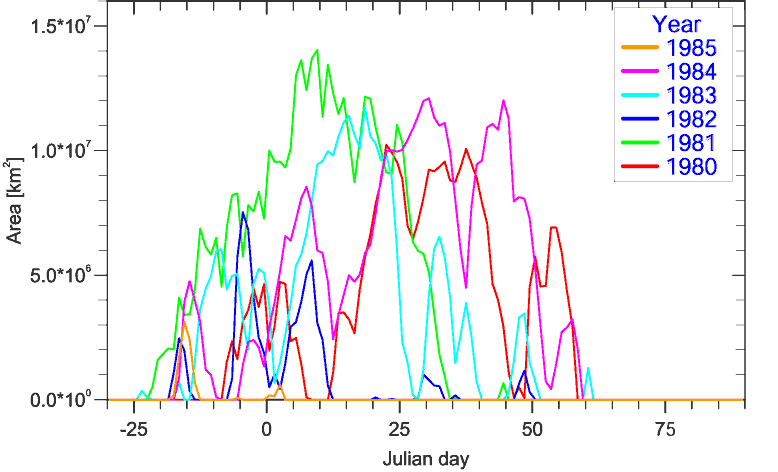 |
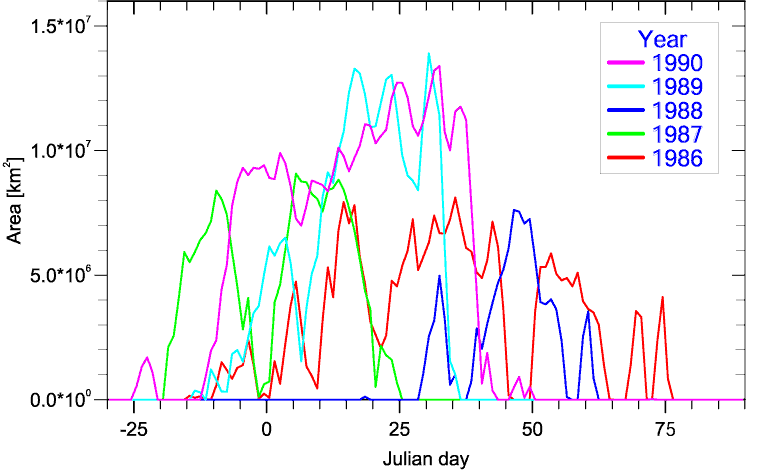 |
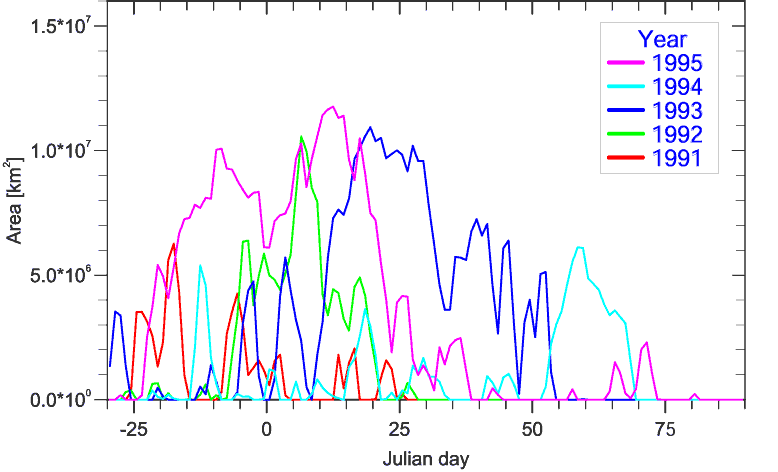 |
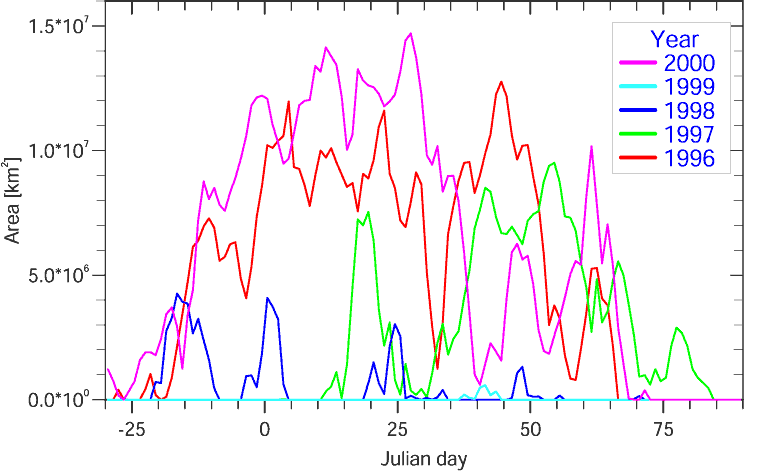 |
From Figure 7 one can clearly see a tendency towards increasing occurrence of NAT temperatures into the late winter. The first six years (upper left panel) had no NAT temperatures after day 62. During the next ten winters there are several episodes with NAT temperatures until day 77. During the last five winters (lower right panel) there have been episodes with NAT temperatures until day 84. Occurrence of PSCs in the late winter will lead to more ozone loss than a similar amount of PSCs earlier in the winter due to longer days and hence more exposure to sunlight. If this trend continues there is a risk for more severe spring ozone loss in the future.
We have calculated monthly mean PSC areas for each of the four months for the 21 years from 1980 to 2000. The trend in this parameter is shown in Figure 8. The trends for January and February are not significant and the interannual variability is very high throughout the 21-year period. It can be seen that January 2000 has the largest monthly PSC area for any year and month. For March there is a clear positive trend of 14% per year and it is significant at the 2 slevel
Trend calculations
The trends have been calculated as linear least squares fits. The results are given in Table 1. The uncertainties given in the table are one standard deviation.
Table 1. Linear trends (% per year) |
||||
| Parameter | Jan | Feb | Mar | Apr |
| Min. temp. | 0.04 ± 0.08 | -0.02 ± 0.10 | -0.16 ± 0.07 | -0.10 ± 0.05 |
| Vortex area | -0.8 ± 1.5 | 0.7 ± 1.5 | 4.7 ± 1.9 | 9.6 ± 4.5 |
| Mean PV | -0.1 ± 0.2 | 0.36 ± 0.29 | 0.69 ± 0.29 | 0.38 ± 0.17 |
| Vortex strength | -0.8 ± 1.0 | 0.3 ± 1.1 | 2.7 ± 1.3 | 5.2 ± 2.9 |
| PSC Area | -0.46 ± 3.06 | 0.87 ± 3.92 | 14.0 ± 5.9 | no PSCs |
The Antarctic Vortex
So far, only the vortex area has been studied. The geographical area within suitable PV contours, depending on the level, has been calculated for every day from May through December for all the years from 1979 up to present, excluding 1994, for which no data was available. Monthly means for the months September through December have been made and are shown in the plots below. The study has been carried out for the isentropic levels 400, 425, 450, 475, 500 and 550 K. The PV limits for the levels are chosen as: -16, -22, -30, -34, -50 and -78 PVU, respectively.
Daily Vortex Areas
Time series of the vortex area at various levels have been calculated and are presented in Figure 9. It can be seen from these figures that the vortex area in September reached a size never reached before in the 1990s.
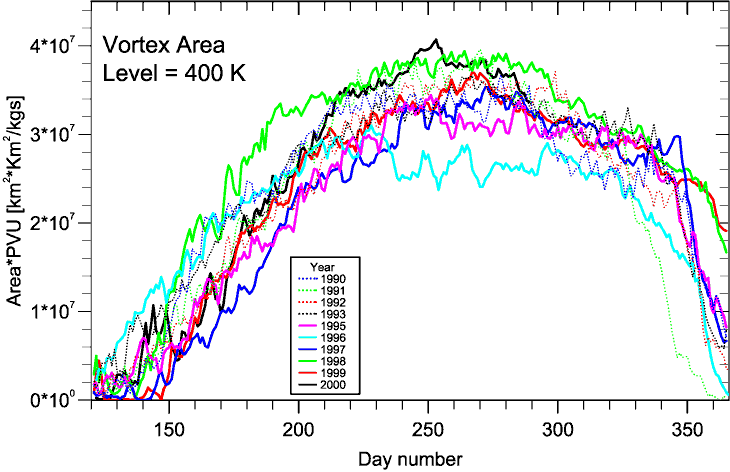 |
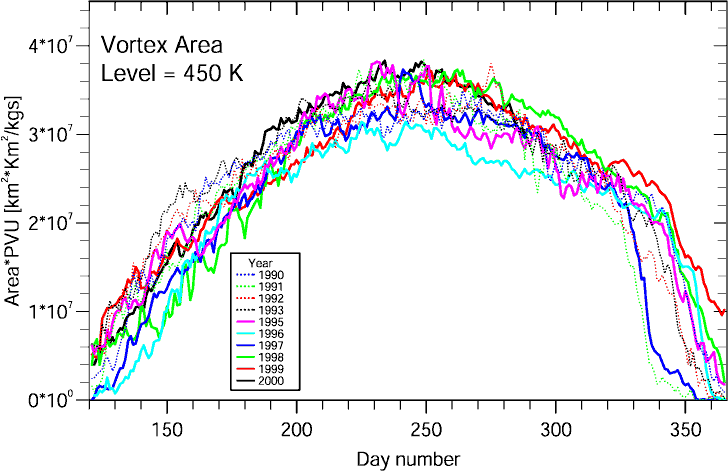 |
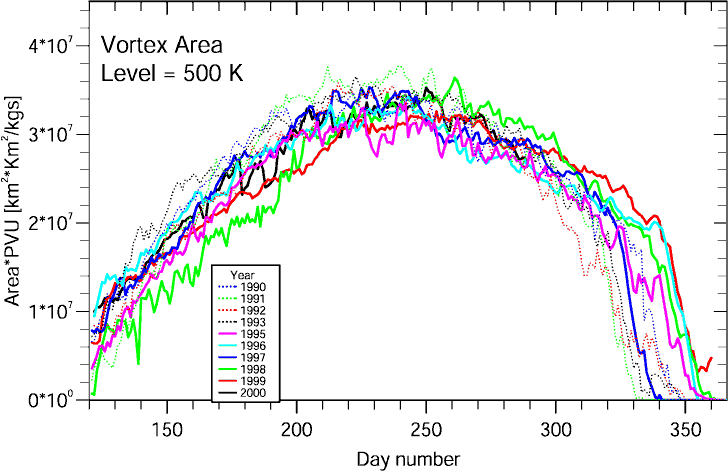 |
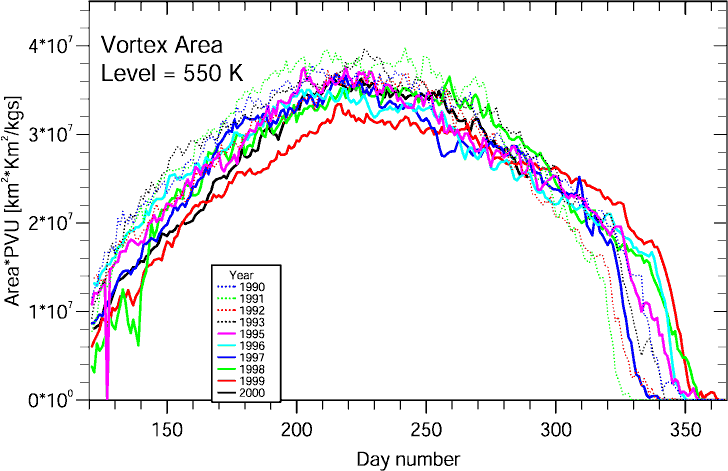 |
Monthly means
Monthly average values of the vortex area has been calculated for several levels and for the months Sept. - Dec. Figures 10-13 show the development of the vortex area at 400, 450, 500 and 550 K from 1979 to present. Table 2 shows the trend values with their one sigma uncertainties.
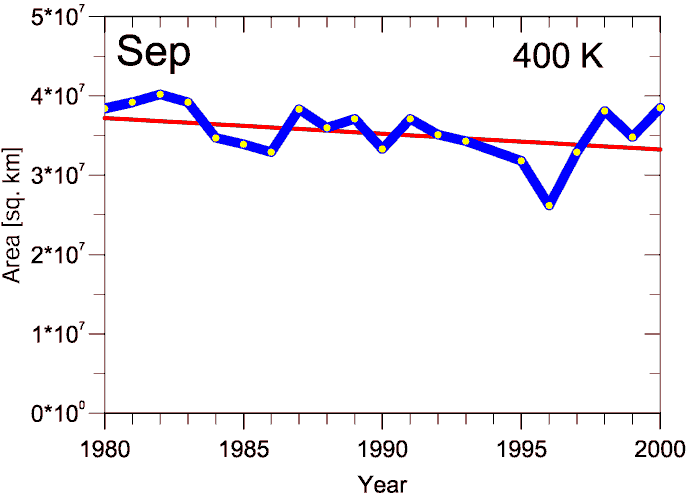 |
 |
||||||||||||
 |
|
 |
 |
||||||||||||
 |
|
 |
 |
||||||||||||
 |
|
 |
 |
||||||||||||
 |
|
Table 2. Linear trends (% per year) in the monthly mean vortex area for the south polar vortex |
||||
| Level/Month | Sep | Oct | Nov | Dec |
| 400 | -0.5 ± 0.3 | 0.2 ± 0.3 | 1.8 ± 0.5 | 7.8 ± 1.3 |
| 425 | 0.0 ± 0.3 | 0.2 ± 0.3 | 2.3 ± 0.6 | 8.4 ± 1.5 |
| 450 | 0.4 ± 0.2 | 1.0 ± 0.3 | 2.2 ± 0.6 | 9.5 ± 2.3 |
| 475 | -0.1 ± 0.2 | 0.3 ± 0.3 | 2.0 ± 0.6 | 9.4 ± 2.3 |
| 500 | -0.3 ± 0.2 | 0.8 ± 0.3 | 6.7 ± 1.5 | 17.9 ± 4.4 |
| 550 | -0.4 ± 0.2 | 0.3 ± 0.3 | 3.8 ± 1.1 | 14.2 ± 4.3 |
Conclusions
Five different indicators, that in different ways describe and characterise the Arctic vortex, have been studied at the 475 K isentropic level. Monthly means of these indicators have been calculated for the months January through April for the years 1980 to 2000. The aim of this study has been to determine if any of these monthly means shows a significant trend during this 21-year period. By a significant trend we here mean a trend that has a larger absolute value than twice its standard deviation. It can be seen from Table 1 that none of these five indicators exhibit any significant trend for the months of January and February. For the month of March, however, all five indicators show trends that are above the 2 slevel. For April only four of the parameters could be studied because the temperatures have never been below the NAT limit in April during the time period in question. Of the four remaining indicators there are three that show significant trends (minimum temperature, mean PV and vortex area), whereas the vortex strength indicator has a trend that is well above the 1 slevel.
From this study it can not be concluded that the Arctic vortex has undergone any significant change during January and February. It is clear however that the vortex in March has become significantly colder and stronger. To a large extent the same also applies to the month of April. It also looks as if the interannual variability for several of the indicators has increased during the last years. The very cold winters of 1995-96 and 1999-00 together with the very mild winters of 1997-98 and 1998-99 are the main reason for this. Our results are in line with the work of Zhou et al. (2000), who showed that the vortex in the northern hemisphere has lasted 4 weeks longer in the 1990s than in the early 1980s.
In the Antarctic only one parameter has been studied, namely the vortex area. Six levels from 400 to 550 K have been studied. For the month of September there is no significant trend for this parameter, except for the 450 K level, where there has been a small increase of 0.4% per year. At the 550 K level there has been a decrease of 0.4% per year. For the month of October there is also no large change, but at 450 K and 500 K there is a significant increase of 1.0 and 0.8% per year, respectively. For the months of November and December there has been a significant increase in the vortex area at all 6 levels. For both these months and for all the six levels the trends are significant to better than 3 s, in many cases better than 4 s.
It is a common feature to both the Arctic and Antarctic that there is a significant trend towards an increasing vortex in late winter, at the time when the vortex is about to break up. It is quite likely that this trend is caused by the destruction of ozone, which leads to a colder vortex that can exist further into the spring. Large vortex areas are found in years with substantial ozone depletion, such as 1995, 96 and 97 in the Arctic and 1987, 93 and 98 in the Antarctic. The results from Antarctica must be considered as preliminary as there was no data from 1994 included in this study. It is unlikely, however, that the inclusion of 1994 will change the general result, namely that November and December have experienced a significant increase in the size of the vortex.
Acknowledgements
The authors are grateful to the ECMWF for the access to the ERA-15 data set and the daily global T106 analyses. We also wish to thank Bojan Bojkov for the work involved in collecting the data and for the provision of routines for data extraction.
References
Zhou, S., M.E. Gelman, A.J. Miller, and J.P. McCormack, An Inter-hemisphere Comparison of the Persistent Stratospheric Polar Vortex, Geophys. Res. Lett., 27, 1123-1126, 2000.
Back to
| Session 1 : Stratospheric Processes and their Role in Climate | Session 2 : Stratospheric Indicators of Climate Change |
| Session 3 : Modelling and Diagnosis of Stratospheric Effects on Climate | Session 4 : UV Observations and Modelling |
| AuthorData | |
| Home Page | |

